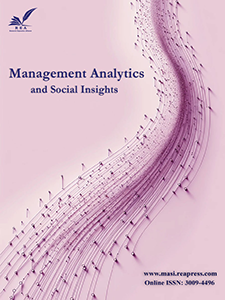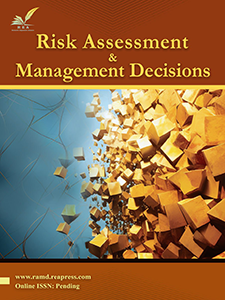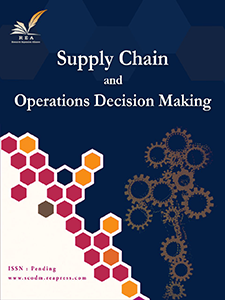Guide for Authors
Content
- Manuscript submission
- Title page
- Article structure
- Text
- Tables
- Figures
- Equations
- Statements & Declarations
- References
- Supplementary information
- Authorship principles
- Authors’ ethical responsibilities
- Competing interests
- After acceptance
- Editing services
- Copyright agreement
Manuscript submission
Manuscript submission
By submitting a manuscript, you confirm that it is an original work, has not been published before, and is not under consideration for publication elsewhere; If accepted, it will not be published elsewhere in the same form or in any other language. All articles must be written in English and undergo independent peer review. The publisher will not be held legally responsible should there be any compensation claims.
Article Processing Charge (APC)
APEM does not charge for article processing during submission, refereeing, or publication.
Permissions
Authors must obtain permission from copyright owners to use previously published figures, tables, or text passages and include evidence of approval when submitting papers. Material without evidence will be assumed to originate from the authors.
Source Files
Please ensure you provide all relevant editable source files at every submission and revision. Please always submit your manuscript text in common word processing formats such as .docx or doc.
Article Types
Research articles, review articles, case studies, and technical notes.
Submission Requirements
Please ensure that the following items are available:
- One author has been designated as the corresponding author with contact details:
- E-mail address
- Full postal address
All necessary files to be uploaded:
- Manuscript:
- Include keywords
- All figures (include relevant captions)
- All tables (including titles, descriptions, and footnotes)
- Ensure all figure and table citations in the text match the files provided
- Supplemental files (where applicable)
- Further considerations
- Manuscript has been 'spell checked' and 'grammar checked.'
- All references mentioned in the Reference List are cited in the text, and vice versa
- Permission has been obtained for use of copyrighted material from other sources (including the Internet)
- A competing interest statement is provided, even if the authors have no competing interests to declare
- Journal policies detailed in this guide have been reviewed
- Referee suggestions and contact details provided based on journal requirements
Title Page
Title Page
Please ensure your title page includes the title, author information, abstract, and keywords. (Title page template)
Title
The title should be concise yet informative, typically 200 to 250 words.
Author information
- The name(s) of the author(s)
- The affiliation(s) of the author(s), i.e., institution, (department), city, (state), country
- A clear indication and an active e-mail address of the corresponding author
- If available, the 16-digit ORCID of the author(s); mandatory for the corresponding author
For authors that are (temporarily) unaffiliated, we will only capture their city and country of residence, not their e-mail address, unless specifically requested.
Large Language Models (LLMs), such as ChatGPT, do not currently satisfy our authorship criteria. Notably, attribution of authorship carries accountability for the work, which cannot be effectively applied to LLMs. The use of an LLM should be appropriately documented in the Methods section (and if a Methods section is not available, in a suitable alternative part) of the manuscript.
Abstract
Please provide a 200-250 word abstract without undefined abbreviations or references. When writing an abstract, it's essential to include information on the research problem, its significance, gaps in current knowledge, what the study contributes to, the methodology used, and the results obtained.
Keywords
Please provide 4 to 6 keywords that can be used for indexing purposes.
Article structure
Abstract
A clear and factual abstract is necessary. It should briefly state the research purpose, principal results, and major conclusions. The abstract should stand alone, so avoid references. If necessary, cite the author(s) and year(s). Also, avoid non-standard or uncommon abbreviations. If essential, define them at their first mention in the abstract. The Abstract should be about 150-250 words.
Introduction
Provide the research problem, objectives, and background without a detailed literature survey or summary of results.
Methodology
A methodology section should extend, not repeat, the background to the article already dealt with in the Introduction and lay the foundation for further work. In contrast, the methodology section represents a practical development from a theoretical basis.
Results
Results should be clear and concise.
Discussion
This section should discuss the significance of the results, not restate them. Combining the Results and Discussion is often suitable. Avoid extensive citations and discussion of published literature.
Conclusions
The primary findings of the study can be summarized in a brief Conclusions section, which can either be an independent section or be part of the Results and Discussion section.
Appendices
If there are multiple appendices, label them as A, B, and so on. Number equations and formulae separately within each , such as Eq. (A1), Eq. (A.2), and so on. Likewise, label tables and figures as Table A1 and Fig. A1, respectively.
Highlights
Highlights are optional but highly recommended for Computational Engineering and Physical Modeling as they enhance your article's discoverability on search engines. They are a brief list of bullet points that summarize the novel results of your research and any new techniques used during the study. Highlights should be submitted as a separate editable file in the online submission system and have 'Highlights' in the filename. Please include 3 to 5 bullet points, with a maximum of 85 characters, including spaces, per bullet point.
Text
For submissions, we encourage authors to use our Template (Word & LaTeX) when preparing a submission.
Please make sure to include all necessary editable source files with each submission and revision.
The submission should include both the original source (including all style files and figures) and a PDF version of the compiled output.
Headings
Please use the decimal system of headings with no more than three levels.
Abbreviations
Abbreviations should be defined at first mention and used consistently after that.
Footnotes
Footnotes should give additional information. They should be numbered consecutively, not including bibliographic details, figures, or tables. Footnotes to the title or the article's authors are not given reference symbols. Using footnotes instead of endnotes is highly recommended.
Scientific style
Please always use internationally accepted signs and symbols for units (SI units).
Please use the standard mathematical notation for formulae, symbols, etc.:
For more information, you may see the following link:
https://en.wikipedia.org/wiki/International_System_of_Units
Tables
All tables are to be numbered using Arabic numerals.
Tables should always be cited in the text in consecutive numerical order.
Tables should be placed as close as possible to where they are cited.
For each table, supply a table caption (title) explaining its components.
Identify any previously published material by referencing the original source at the end of the table caption.
Footnotes to tables should be indicated by superscript lower-case letters (or asterisks for significance values and other statistical data) and included beneath the table body.
Table captions should be center-aligned above the table body, Garamaod 10 points, bold, and in sentence case.
Figures
All figures are to be numbered using Arabic numerals.
Figures should always be cited in the text in consecutive numerical order.
Figures should be placed as close as possible to where they are cited.
Figure parts should be denoted by lowercase letters (a, b, c, etc.).
If an appendix in your article contains one or more figures, continue the consecutive numbering of the main text. Do not number the appendix figures, "A1, A2, A3, etc." However, figures in online appendices (Supplementary Information SI) should be numbered separately.
Each figure should have a concise caption describing accurately what the figure depicts. Include the captions in the manuscript's text file, not the figure file.
Figure captions begin with the term Fig. in bold type, followed by the figure number in bold type.
Identify all elements found in the figure in the figure caption, and use boxes, circles, etc., as coordinate points in graphs.
Identify previously published material by giving the original source as a reference citation at the end of the figure caption.
Figures should be submitted within the body of the text. Only if the file size of the manuscript causes problems in uploading it the large figures should be submitted separately from the text.
When preparing your figures, size figures to fit in the column width.
Figure captions should be center-aligned below the figures, Garamaod 10 points, bold, and in sentence case.
If figures have been previously published, permission from the copyright owner(s) must be obtained.
To make your figures accessible to everyone, provide descriptive captions that can be read by text-to-speech software or text-to-Braille hardware.
Ensure all lines and lettering within figures are legible at final size, with a minimum width of 0.1mm (0.3pt). Avoid using faint lines or lettering.
Equations
Ensure the symbols in your equation have been defined before the equation appears or immediately follows. Each equation must be written by MathType or Equation Tool.
Statements & Declarations
The section titled 'Statements and Declarations' must be included in your manuscript after the References section, as manuscripts without these required statements will be returned as incomplete.
Acknowledgments
Acknowledgments enable you to thank all those who have helped carry out the research. Careful thought needs to be given concerning those whose help should be acknowledged and in what order. The general advice is to express your appreciation concisely and to avoid strong emotive language.
Author Contributions
For research articles with multiple authors, provide a short paragraph that identifies each contribution. The following statements should be used: "Conceptualization, X.X., and Y.Y.; Methodology, X.X.; Software, X.X.; Validation, X.X., Y.Y., and Z.Z.; formal analysis, X.X.; investigation, X.X.; resources, X.X.; data maintenance, X.X.; writing-creating the initial design, X.X.; writing-reviewing and editing, X.X.; visualization, X.X.; monitoring, X.X.; project management, X.X.; funding procurement, Y.Y. All authors have read and agreed to the published version of the manuscript. Authorship must be limited to those who have contributed significantly to the work reported. All terms were described in the CT file.
Please refer to the following link for guidance on "Authorship Principles."
Funding
This section indicates any support not included in the Author Contribution or Funding sections. This may include administrative and technical support or in-kind donations (e.g., experiment materials). The statement should include details of any grants received (please give the name of the funding agency and grant number).
Example statements:
“This work was supported by […] (Grant numbers […] and […]). Author A.B. has received research support from Company A.”
“The authors declare that no funds, grants, or other support were received during the preparation of this manuscript.”
Data Availability
We encourage all authors to make their research data available. Please indicate where the data supporting the reported findings can be found, including links to publicly archived datasets that were analyzed or generated during the study. If no new data were generated or data is unavailable due to privacy or ethical restrictions, an explanation is still required. The suggested Data Availability Statements were collected in the DAS file.
Example statements:
"The datasets generated during and/or analyzed during the current study are available in the [NAME] repository, [PERSISTENT LINK TO DATASETS]."
"The datasets generated during and/or analyzed during the current study are not publicly available due to [REASON(S) WHY DATA ARE NOT PUBLIC] but are available from the corresponding author on reasonable request.]."
Conflicts of Interest
Authors must declare any financial or non-financial personal circumstances or interests that could be considered to have an inappropriate influence on the presentation or interpretation of the reported research findings. Any role of funders in the study's design, in the collection, analysis, or interpretation of the data, in the writing of the manuscript, or in the decision to publish the results must be disclosed in this section. If this is not the case, please indicate, "Funders played no role in the design of the study, in the collection, analysis, or interpretation of the data, in the writing of the manuscript, or in the decision to publish the results." You can see more details in the CID file.
References
Citation
In text. Indicate references by number(s) in square brackets in line with the text. The actual authors can be referred to, but the reference number(s) must always be given. Number the references (numbers in square brackets) in the list in the order they appear in the text. The list of references should only include works that are cited in the text and that have been published or accepted for publication. Personal communications and unpublished works should only be mentioned in the text.
References should be written in Palatino Linotype 9 pt. Font and multiple line spacing at 1.15 based on the following style:
Reference to a journal publication:
- Youssf, O., ElGawady, M. A., & Mills, J. E. (2016). Static cyclic behavior of FRP-confined crumb rubber concrete columns. Engineering structures, 113, 371-387. https://doi.org/10.1016/j.engstruct.2016.01.033
Reference to a book:
- Liao, H., & Xu, Z. (2017). Hesitant fuzzy decision making methodologies and applications. Springer Singapore.
Reference to a chapter in an edited book:
- McKenzie, R.B. (2018). From robbins to friedman and beyond. In A brain-focused foundation for economic science (pp. 63-92), Palgrave Macmillan, Cham. Springer. https://doi.org/10.1007/978-3-319-76810-6_3
Reference to a conference paper:
- Hakani Raj, A. (2010, May). Development of an intelligent sensor based inspection robot for closed environment. Proceedings of the 2015 5th Nirma University international conference on engineering (NUiCONE) (pp. 1-6). IEEE.
Reference to a website:
- Murphyn, L. (n.d.). Utrition & exercise - timing is everything. NASM. https://blog.nasm.org/workout-and-nutrition-timing
If available, please always include DOIs as full DOI links in your reference list (e.g., “https://doi.org/abc”).
Note: using the Mendeley tool and following the REA press style is recommended.
Please consider the steps below:
Install the Mendeley, then register and log in. Open the Mendeley program and select View->Citation Style->Get More Style. Paste the link” https://csl.mendeley.com/styles/699351941/REA” in the “Download style” box and select download., then click done.
Supplementary Information
Supply all supplementary material in standard file formats. Please include in each file the following information: article title, author names, affiliation, and e-mail address of the corresponding author.
Submit your material in PDF and doc format. A collection of figures may also be combined in a PDF file.
Spreadsheets should be submitted as .csv or .xlsx files (MS Excel).
If supplying any supplementary material, the text must mention the material as a citation, similar to that of figures and tables.
Please name the files consecutively.
Supplementary Information will be published exactly as the author submits, without alterations.
Authorship principles
The following recommendations are intended to ensure that contributors who have made substantive intellectual contributions to a paper are given credit as authors and that contributors credited as authors understand their role in taking responsibility and being accountable for what is published. APEM request and publish information about the contributions of each person named as having participated in a submitted study, at least for original research. Prospective authors should adhere to these guidelines that describe authorship principles and good practices.
Contributors
Contributor is qualified based on the following 4 criteria:
- Substantial contributions to the conception or design of the work; or the acquisition, analysis, or interpretation of data for the work;
- Drafting the work or reviewing it critically for important intellectual content;
- Final approval of the version to be published;
- Agreement to be accountable for all aspects of the work in ensuring that questions related to the accuracy or integrity of any part of the work are appropriately investigated and resolved.
All authors must meet the four criteria for authorship. Those who do not must be acknowledged. The criteria cannot be used to disqualify colleagues from authorship. All individuals who meet the first criterion should have the opportunity to participate in the review, drafting, and final approval of the manuscript.
Authors should have confidence in the integrity of the contributions of their co-authors.
Non-Author Contributors
Contributors who do not meet all 4 authorship criteria should not be listed as authors but rather acknowledged. Activities such as acquiring funding, supervising a research group, providing general administrative support, and language editing alone (without other contributions) do not qualify a contributor for authorship.
The contributions of the non-author contributors should be explicitly stated (e.g., "served as scientific advisors," "critically reviewed the study proposal," "collected data," "provided and cared for study patients," "participated in writing or technical editing of the manuscript").
Artificial Intelligence (AI) Assistance
Authors who use such technology should describe how they used it in both the cover letter and the submitted work. Chatbots (such as ChatGPT) should not be listed as authors because they cannot be responsible for the work's accuracy, integrity, and originality, and these responsibilities are required for authorship. Authors should carefully review and edit the result because AI can generate authoritative-sounding output that can be incorrect, incomplete, or biased. Authors should be able to assert that there is no plagiarism in their paper, including in text and images produced by the AI. Humans must ensure appropriate attribution of all quoted material, including full citations.
Changes to authorship
Authors are strongly advised to ensure the correct author group, the Corresponding Author, and the order of authors at submission. Changes of authorship by adding or deleting authors, and/or changes in Corresponding Author, and/or changes in the sequence of authors are not accepted after acceptance of a manuscript.
Please ensure all authors' names are present and correctly spelled and addresses and affiliations are current. Author names will be published exactly as they appear on the accepted submission!
Adding and/or deleting authors at the revision stage is generally not permitted, but it may be warranted in some cases. The reasons for these changes in authorship should be explained. Approval of the change during revision is at the discretion of the Editor-in-Chief.
Authorship issues or disputes
In the case of an authorship dispute during peer review or after acceptance and publication, the Journal cannot investigate or adjudicate. Authors will be asked to resolve the dispute themselves. If they are unable, the Journal reserves the right to withdraw a manuscript from the editorial process or, in the case of a published paper, raise the issue with the authors’ institution(s) and abide by its guidelines.
Authors’ Ethical Responsibilities
APEM is committed to upholding the integrity of the scientific record and follows the Committee on Publication Ethics (COPE) guidelines on how to deal with potential acts of misconduct.
Authors must adhere to scientific practice to maintain research integrity and prevent misrepresentations that could damage trust in the journal and scientific authorship.
Manuscripts must be submitted in English and written according to sound grammar and proper terminology.
Manuscripts must be submitted with the understanding that they have not been published elsewhere (except as an abstract or as part of a published lecture, review, or thesis) and are not currently under consideration by another journal or any other publisher.
A single study should not be split into several parts to increase the number of submissions to various journals or to one journal over time (salami-slicing/publishing).
Results should be presented clearly and honestly without fabrication, falsification, or inappropriate data manipulation. Authors should adhere to discipline-specific rules for acquiring, selecting, and processing data.
No data, text, or theories by others are presented as if they were the author's own (plagiarism). Proper acknowledgments to other works must be given (this includes material that is closely copied (near verbatim), summarized, and/or paraphrased), quotation marks (to indicate words taken from another source) are used for verbatim copying of material, and permissions secured for material that is copyrighted.
If appropriate, authors should ensure they have permission to use software, questionnaires/(web) surveys, and scales in their studies.
Adding and/or deleting authors during the revision stages is generally not permitted but, in some cases, may be warranted. Reasons for changes in authorship should be explained in detail. Please note that changes to authorship cannot be made after acceptance of a manuscript.
To sustain the peer review system, authors must participate in the peer review process to evaluate manuscripts from others.
It is also the author's responsibility to ensure that the manuscripts emanating from a particular institution are submitted with the approval of the necessary institution.
It is a condition for submission of a manuscript that the authors permit editing of the paper for readability.
Authors are requested to identify who provided financial support for the manuscript's research and/or preparation and briefly describe the role of the founder/ sponsor in any part of the work.
A copyright release form must be signed by the corresponding author in case of multiple authorship, before the acceptance of the manuscript, by all authors for publication to be legally responsible towards the Journal's ethics and privacy policy.
Under open access license, authors retain ownership of the copyright for their content but allow anyone to download, reuse, reprint, modify, distribute, and copy the content as long as the original authors and source are appropriately cited.
Upon request, authors should be prepared to send relevant documentation or data to verify the validity of the presented results. This could be in the form of raw data, samples, records, etc. Sensitive information in the form of confidential or proprietary data is excluded.
The manuscript should clearly identify any research that could be used to harm public health or national security, such as dual-use research. This includes creating harmful biological agents or toxins, disrupting vaccine immunity, using hazardous chemicals, or weaponizing research or technology.
All authors have agreed to allow the corresponding author to serve as the correspondent with the editorial office to review the edited manuscript and proof.
When the author(s) discovers a significant error or inaccuracy in their published work, they must promptly notify the journal editor or publisher to retract or correct the manuscript.
Articles must cite appropriate and relevant literature supporting the claims made. Excessive and inappropriate self-citation or coordinated efforts among several authors to collectively self-cite is strongly discouraged.
All authors must know that the submitted manuscripts under review or published with APEM are subject to screening using Plagiarism Prevention Software. Plagiarism is a severe violation of publication ethics.
All authors should treat all communication with the Journal as confidential, including correspondence with direct representatives from the Journal, such as Editors-in-Chief and/or Handling Editors and reviewers’ reports, unless explicit consent has been received to share information.
All authors must ensure that all authors have read the submission final checklist before being submitted to the Annals of Process Engineering and Management.
Corresponding Author’s Responsibility
The submitting corresponding author is responsible for ensuring that all the other coauthors have approved the manuscript article's publication.
Corresponding Author is strongly advised to ensure the author group, the Corresponding Author, and the order of authors are all correct at submission.
The corresponding author must receive agreement from all co-authors to serve as the correspondent with the editorial office to review the edited manuscript and proof.
The corresponding author should be prepared to collect documentation of compliance with ethical standards and send it if requested during peer review or after publication.
Suggesting/excluding reviewers
Authors are welcome to suggest suitable reviewers and/or request the exclusion of specific individuals when they submit their manuscripts. When suggesting reviewers, authors should make sure they are totally independent and not connected to the work in any way. Suggesting a mix of reviewers from different countries and institutions is strongly recommended. When suggesting reviewers, the Corresponding Author must provide an institutional email address for each suggested reviewer. Please note that the Journal may not use the suggestions, but suggestions are appreciated and may help facilitate the peer review process.
Competing Interests
Authors are asked to disclose interests related to submitted work within the last three years. Interests outside the 3-year timeframe should be reported if they could reasonably influence the submitted work. Disclosure of interests helps readers form their own judgments of potential bias. Financial relationships with an organization that sponsored the research or compensation received for consultancy work are not inappropriate.
Competing interests should be summarized in a statement and placed in a ‘Declarations’ section before the reference list under the heading of ‘Funding’ and/or ‘Competing interests’’.
When all authors have the same (or no) conflicts and/or funding, it is sufficient to use one blanket statement.
Primary research articles require a disclosure statement. Review articles present an expert synthesis of evidence and may be treated as authoritative work on a subject. If you are unclear whether your article type requires a disclosure statement, please get in touch with the Editor-in-Chief.
Interests that should be considered and disclosed but are not limited to the following:
- Funding: Please provide the research funder and grant number for research grants. For research support, including salaries, equipment, supplies, reimbursement for attending symposia, and other expenses, please disclose any organizations that may gain or lose financially through the publication of your manuscript.
Here are some statements to use when you have received funding:
- This work was funded by […]
- This study was supported by […] (Grant numbers […] and […]
- Partial financial support was received from [...]
Here are some statements to use when funding is not available:
- No funds, grants, or other support were received.
- The study was not supported by any organization.
- No funding was received to aid with the manuscript preparation.
- No funding was received for conducting this study.
- Employment: Recent (while engaged in the research project), present, or anticipated employment by any organization that may gain or lose financially through the publication of your manuscript. This includes multiple affiliations (if applicable).
- Financial interests: Stocks or shares in companies (including holdings of spouse and/or children) that may gain or lose financially through publication of your manuscript; consultation fees or other forms of remuneration from organizations that may gain or lose financially; patents or patent applications whose value may be affected by publication of your manuscript.
Here are some statements to use when you have financial interests:
- Author A has received research support from Company X. Author B has received a speaker honorarium from Company Y. Author C is a consultant to Company Z.
- Author A received a speaking fee from Y for Z. Author B receives a salary from association X. X where he/she is the Executive Director.
- Authors A and B declare they have no financial interests. Author C has received speaker and consultant honoraria from Company X. Author D has received travel support from Company Y.
When you do not have a financial interest, you can declare:
- The authors have no financial interests.
- Non-financial interests: Authors are asked to disclose interests beyond financial interests that could impart bias on the work submitted for publication, such as professional interests, personal relationships, or personal beliefs (amongst others). Examples include but are not limited to position on an editorial board, advisory board or board of directors, or other type of management relationships; writing and/or consulting for educational purposes; expert witness; mentoring relations; and so forth.
Here are some statements to use when you have non-financial interests:
- Author A is an unpaid member of Committee X.
- Author B is on the board of directors of Y and receives no compensation as a board of directors member.
- Author C has served on advisory boards for Company Z.
Here are some statements that can be used when authors have no conflicts of interest to declare:
- The authors have no relevant financial or non-financial interests to disclose.
- The authors have no competing interests to declare relevant to this article's content.
- All authors certify that they have no affiliations with or involvement in any organization or entity with any financial or non-financial interest in the subject matter or materials discussed in this manuscript.
- The authors have no financial or proprietary interests in any material discussed in this article.
Editing services
Well-structured manuscripts and well-written English increase the chances of editors and reviewers understanding and evaluating your work fairly. Researchers can seek independent support from REA Press for manuscript preparation, including English language editing, developmental comments, manuscript formatting, figure preparation, translation, and more. Please note that using this service is not required for publication. It also does not guarantee that editors will accept the article or select it for peer review.
After acceptance
Upon acceptance, your article will be exported to the pre-publication section for typesetting. Once typesetting is complete, you will receive a link asking you to confirm your affiliation, check the proof, etc.
The purpose of the proof is to check for typesetting or conversion errors and the completeness and accuracy of the text, tables, and figures. Substantial changes in content, e.g., new results, corrected values, title, and authorship, are not allowed without the approval of the Editor. After online publication, further changes can only be made in the form of an Erratum, which will be hyperlinked to the article.
The article will be published online after receipt of the corrected proofs. This is the official first publication citable with the DOI. After the release of the final version, the paper can also be cited by issue and page numbers.
Copyright agreement
When a manuscript has been submitted for publication by the journal, authors will be requested to fill and sign the below copyright agreement to grant publisher rights to the journal. These rights include the exclusive right to publish and distribute the accepted article in all forms and media and the authority to enforce the rights in the article on behalf of an author against third parties in cases of plagiarism or copyright infringement. We recommend authors download the Copyright Agreement and Conflict of Interest Statement and confirm the ethical issues involved in the mentioned file. Afterward, the Copyright Agreement is attached to the article submitting steps.


 Metrics
Metrics



